Free Article: Why do ships ‘zig’ when they should have ‘zagged’?
The role of ‘unconventional’ simulator use in assessing communication on the bridge
Stephen Window AFNI Head of The Nautical Institute Academy
Keeping a safe navigation watch onboard a modern merchant vessel demands a high level of competency in many skills. The cognitive demands on individuals and teams alter commensurately with increasing complexity and change within the deck officer’s role.
Paradoxically, increasing technology that focuses on safety and improved situational awareness, using satellite positioning systems and ECDIS, along with other high-automation tools such as collision avoidance radar, does not necessarily make for safer operating environments. However, it can be hard to assess how the use of these tools affects performance if all we do is repeat the standard procedures with no alteration. We can observe that anomalies and deviation occur, but it can be hard to isolate why.
The creative use of simulators allows us to approach these problems in an unconventional way. Rather than attempting to replicate reality, they can offer more imaginative ways to identify issues, enhance learning by generating behaviour change, and reduce the risk of confirmation bias.
In attempting to understand why assessments and actions that, from the outside look like really bad ideas, appear from the inside, unremarkable, routine, normal or systematically connected to features of the work environment (Dekker, 2011), I developed two unconventional exercises: the leaderless bridge exercise and the ‘blindfolded master’. In addition to five conventional simulation exercises, Bridge Team Management students carried out two unconventional exercises that focused on the role of communication in bridge operations. Participants were observed during the exercise, and interviewed afterwards.
The leaderless bridge scenario
The ‘leaderless bridge’ exercise required two qualified mariners of various rank – up to and including experienced Masters – to navigate the vessel in full compliance with the Colregs.
The catch is that no verbal or non-verbal communication was permitted between the two watchkeepers on the bridge. Both were operating under the same set of instructions and with the same data inputs available – which should have led to an implicit shared mental model. The actions which should be taken were quite clear under the Colregs; this was not a situation where there was any question of interpretation.
The ‘student’ vessel (shown in red) is proceeding to the North-East to join the Gibraltar TSS. The vessel Green Crystal has exited the TSS and alters course to the South-West. On completion of the alteration and at a range of 12 miles, the Green Crystal is on a steady bearing with the student vessel. The prevailing visibility is 3nm.
It may be asserted [dependent upon the vessel’s manoeuvrability] that six miles is too early to take action, with the exception of reducing speed, as a large vessel moving at high speed will be carrying too much momentum to rapidly slow down.
By applying the trial manoeuvre facility on the radar, a minimum Closest Point of Approach (CPA) of one mile by manoeuvre alone was achievable in this exercise – which Cockcroft assesses to be the minimum acceptable CPA to allow safe passing in open water. Out of the 26 exercises that I ran, only one bridge achieved this.
If the manoeuvres were inconsistent, the actions of the participants proved equally variable, ranging from absolute harmony to outright conflict. With both officers having command authority, but disallowed from making verbal communication, some participants felt compelled to physically push their colleague away from the controls when they perceived either a lack of action or inappropriate action being taken to avoid collision. Countermanding or negating actions to avoid collision were taken in 22 exercises. This casts considerable doubt on the existence of a shared mental model based on the observable facts and knowledge of Colregs alone.
After the event
Group debriefs were conducted as part of reflection-after-action. To check the participants’ understanding of the Colregs, a short examination using multiple-choice questioning as the means of assessment was employed. All officers scored 100% in those questions related to the actions of the stand-on and give-way vessels, as well as those rules relating to restricted visibility, crossing, head-on and overtaking situations.
Putting the provisions of Rule 19 aside, all of the participants, including those that turned to port, thereby contravening Rule 17, believed that their initial action was appropriate for the developing situation. This gives a strong indication that the underlying aim was satisficing – that is, acting in such a way as to satisfy the minimum requirements to avoid collision and to achieve passing at a ‘safe’ distance, irrespective of the requirements of the Colregs. One participant, a senior master whose run showed a complete disregard for the requirements of Rules 8 and 17, felt that the exercise: “Did not really work in our case, as I knew that both me and my colleague have plenty of experience and would naturally take the right action.”
Satisficing
In all 26 exercises, the observer positioned in the control room found it difficult to comprehend the apparently irrational actions of his colleagues. This may be attributed to the limitations on situational awareness caused by bounded rationality and subsequent decision making processes, or through the normalisation of deviancy – as demonstrated by the feedback, in which no participant stated that their initial actions would have been different in reality.
One observer was asked his thoughts regarding the issue of satisficing and misvention [not following the rules]: “They’re not on a real ship, so we have to think about what the training environment does with a student and, in my experience, having dealt with training sailors for many years now is that, in a training environment you often don’t take such decisive actions as you would do in real life. Why it is so, I really don’t know. But somehow it is probably the fear of doing something wrong, making a little adjustment, hoping it will get you there.”
However, this view was only shared by three participants. The remainder found the exercise credible in terms of being a plausible and common shipping situation, typical of that area. One participant said: “This scenario is typical of this sea area, with the funneling of ships and traffic transiting south after leaving the Med. It’s easier to slide to port to give everyone room.”
Findings from the ‘Leaderless Bridge’ exercise
Although the ‘leaderless bridge’ exercise is unrealistic in that two officers would not normally be exercising command simultaneously, it does raise the question of why, when presented with a straightforward shipping situation requiring them to comply with the requirements as the stand on vessel, the subsequent actions were not universally compliant with the Colregs. Instead, we saw an attempt to take a path of ‘least resistance’, making a succession of small alterations to either port or starboard. Furthermore, in all cases, the officers were operating under the wrong set of rules. Given the range of visibility, they should have been operating under Rule 19 since they could not visually observe Green Crystal.
The extent to which the actions taken were contrary to the requirements of the Colregs may also be seen to endorse Perrow’s (1999) assertion that the error inducing character of the maritime industry lies in the social organisation of the personnel on board ships, in which the behaviour of staff, masters and crews usually flow along the course of least resistance. This is, in turn, determined by their human capacities; their expertise, the expectations, management style and culture of the company; and [their interpretation of the] requirements of the law. This confluence of factors leads to a dilemma that sharp-end operators are supposed to be ‘efficient rather than thorough, except where the outcome shows that they should have been thorough, rather than efficient’ (Schröder-Hinrichs, et al., 2012).
The ‘blindfolded master’ and verbal communication
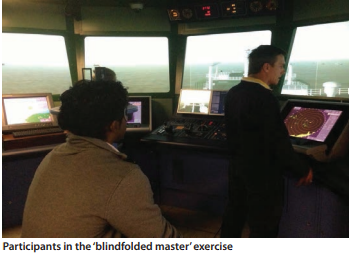
The ‘blindfolded master’ exercise sought to examine the quality of verbal communication by isolating body language and navigation equipment from the master’s decision-making process. The exercise blended ‘unconventional simulation’ and realism to emphasise to the students the importance of clear communications.
Fahlgren (2000) considers that there are three channels to communication of varying importance.
A Maritime Crew Resource Management lecturer succinctly described the role of communication: “Communications are the glue. Without communication nothing can happen safely. The problem is getting people to say what needs to be said, at the right time, and without fear of being slapped down.” The exercise was set in the Dover Straits TSS. Having been briefed by the team on the passage plan through the Dover Straits and planned crossing from the North-East Lane to the East of Dover (below), the designated Master was sat down next to the helmsman and blindfolded. One exercise participant was posted at the ECDIS, and one at the radar, and tasked with relaying information to the master. These two participants could not speak to each other, but only to the master.
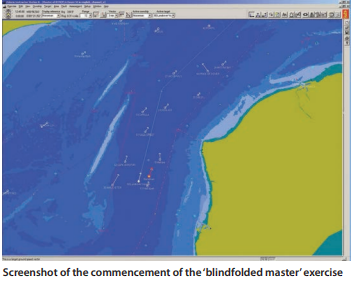
Quality of information: position and track
In all cases, the team developed a regular reporting system, with a statement including:
- Where the ship was in relation to its planned route;
- Safe/unsafe;
- Time to the next alteration of course.
The number of times that the master questioned the ECDIS operator was roughly commensurate with how often a paper chart would be consulted, and was regarded by all participants as appropriate. Although the master was provided with information as requested, it was observed, and confirmed by post-exercise discussion and interview, that, in 80% of the exercises, the ECDIS operator became passive in role: “I felt under-utilised. I was only asked for information about what… every 15 minutes or so.”
The observations, post-exercise debriefs and interviews highlighted that although ECDIS is considered to be a great aid in generating situational awareness, the actual need to seek navigation information from the ECDIS may be far less than the practice of constantly monitoring it would suggest – and this constant checking may perhaps reinforce the risk of confirmation bias where outcomes are not routinely crosschecked.
In none of the 35 exercises was navigation safety compromised, suggesting that the information flow was appropriate to the prevailing situation:
“It was incredible how little I felt the need to get answers from the ECDIS. The information I got, when I asked, was just right. What spooked me was juggling the shipping situation around my head.” All of the interviewees stated that the denial of an ECDIS screen did not affect the performance of the master and the team in the exercises, since the master was given all requested information ‘on demand’ from the OOW. This was corroborated by observation. The third level of situational awareness (anticipating future states) did not appear compromised by the level of ECDIS information, since all participants in the Blindfolded Master exercises either made planned course changes or could provide a coherent reason for not doing so. However, it was considered by all participants that ships should operate with two ECDIS displays to facilitate shared mental modelling.
Quality of information: collision avoidance
While 98% of the participants agreed that position awareness was ‘always achieved’, the same could not be said for flow of information concerning collision avoidance. While the need for navigation information ran on a fairly set schedule, the master constantly sought information regarding collision avoidance. In other words, the blindfolded masters were less concerned with the position of their own ship than the proximity of other vessels: “It showed the importance of what information is really needed to avoid overload. I reckon it was an 80/20 ratio of CPA vs. ECDIS information.”
The reported need for significantly greater amounts of information from the radar operator was primarily attributed to the quality of the information being passed. This was confirmed by the frequency of negative behavioural markers and observations between Master and radio operator. Frustrations were both observed and reported by the master and the operators when information was not being passed in a desired format.
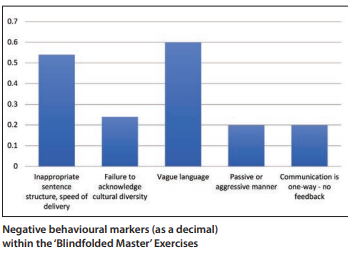
This high incidence of negative behavioural markers reflects an unstructured approach to reporting vessels. This impacted upon the level of situation awareness and the ability for the master to conduct effective decision making:
“It was impossible! Why couldn’t you [Radar Operator] tell me what I needed, rather than what you thought I wanted to hear? I didn’t care that he was going to Rotterdam! I wanted to know his CPA and TCPA…”! It was universally agreed that the master should verbalise the parameters for reporting and minimum acceptable CPA for the prevailing circumstances. By sharing possible options, the risk of cognitive hysteresis – where people fail to revise their initial assessments in response to new evidence – may be reduced (Schröder-Hinrichs et al., 2012).
Whereas all participants agreed a reporting system for position and course alteration, it is notable that only on 15 of 26 occasions was a standardised (agreed) reporting system used for collision avoidance. In eight cases the master became increasingly frustrated at the ‘inability’of the radar operator to give him the service he required. Additionally, with only one notable exception, the radar operator filtered information by not providing information: “I didn’t tell him about that ship to starboard because I thought he was passing clear”
Filtering of information
It is interesting to compare the results from the ‘blindfold master’ exercise with the results from 50 exercises where the master and OOW were operating conventionally. In the conventional exercises, filtering of information routinely occurred, both in terms of ECDIS position information and collision avoidance using the radar. Feedback from these exercises suggested that the rationale behind filtering was based upon the assumption that the master already knew the information that was not being shared, with 76% stating that was the principal reason. Equipment unfamiliarity (ECDIS and radar) was cited in 20% of reasons, while the remaining 4% were cited as being through lack of attention on the part of the operator.
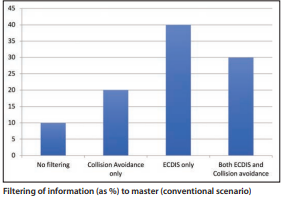
As a comparator, the ‘blindfolded master’ exercise found that while the filtering of information was still prevalent, the master’s need for information and associated questioning overcame the tendency for the ECDIS operator to filter (from 40% to 10%).
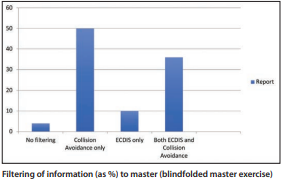
ECDIS and distractions
Recent MAIB investigations indicate that technology is having a positive impact on navigation practices, including a reduction in OOW workload. However, there is a danger of the OOW operating under an illusion of control, while their overall situation awareness has, in fact been reduced. Interviews highlighted that although ECDIS is now universally fitted to ships’ bridges, the transfer from paper navigation to ‘paperless’ remains incomplete and appears to be undertaken reluctantly: “ECDIS not necessarily safer because it lets you think that it is very accurate.” “ECDIS? I’m afraid of it because it is not straightforward. Too many options means too many options to f@*k it up.” Similarly, many participants reported that modern bridges: “…are too bloody noisy! I spend all watch chasing down alarms when I should be looking out the window.” It was considered by the participants (96 out of 104) that although ECDIS may be a useful situational awareness tool, it is actively counterproductive if the person using it is not fully conversant with its capabilities, limitations and menu systems. It is suggested that technical skills in cross-checking ECDIS positions, through the use of complementary position monitoring techniques, must be verbalised to the team. The same must be applied to the use of ARPA Radar and AIS, crosschecking and then verbalising CPAs and Time To CPA’s (TTCPA) to the whole team, thereby sharing a mental model of the prevailing situation.
Validity of the ‘Leaderless Bridge’ and ‘Blindfolded Master’ exercises
The two exercises focused on the importance of communication in generating shared mental models and situational awareness. The post exercise interviews provided the following feedback: “… it gave a great deal of insight into our imagination…forcing you to form a mental image of the scenario, which is painted on your mind through another person’s viewpoint.” “This was useful to show me what and how much information I need to make [a] conclusion without looking at screens” Only two respondents felt that the exercise was not worthwhile, stating that the exercise wasn’t realistic: “This wouldn’t happen at sea, because I would be looking out of the window to confirm what the guys are telling me.” The reflection-after-action discussions and interviewee feedback highlighted a resolution by the participants to significantly change the way in which they verbally presented information (84%).
Summary of findings
The research inquiry provided the following findings:
Finding 1: There is evidence to suggest that normalisation of deviation exists within the seafaring community. Generalising the findings from these exercises to the wider merchant shipping industry is problematic. However, from the simulation exercises observed and the discourse arising from the reflection-after action discussions and associated interviews, there was a strong indication that satisficing and misvention is regarded as commonplace. It is concluded that the normalising of deviation is a significant factor in the paradox that formed the first research question – why ships ‘zig’ when the Rules state, and the Master knows, that they should ‘zag’.
Finding 2: Information is filtered routinely.
When both the command and the OOW are using ECDIS and radar displays, there is a tendency to believe that each is interpreting the picture the same way. The ‘Blindfolded Master’ exercise and observation of participants’ use of electronic aids to navigation indicated that while the command considered that the information flow was sufficient within the parameters of the derived standard, information was not fully shared. The risk of confirmation bias is considered to be increased when the situation is not fully verbalised between team members.
Finding 3: Verbalising information assists in the generation of shared mental modelling and situational awareness
It was found that an efficient bridge team is characterised by the verbalising of both navigation and collision avoidance information, supplemented by discussion of alternative courses of action and the opportunity for challenges to be made by any one of the team, irrespective of position within the hierarchy. Communication supports the generation of situational awareness and the decision-making process. The blindfolded master exercise demonstrated that when the master was solely reliant upon the input of the team for information, there were demands for succinct and clear communication, which may be considered to be lacking at sea. The root cause of such shortfall in communications may be the socially constructed assumption that the other, more senior person must know what is happening.
Finding 4: The setting of acceptable limits and operating parameters by the command (master) is considered essential to safe practice.
It was observed and discussed that in those exercises where limits were not set, the master was effectively relinquishing full command in favour of a laissez-faire approach. It may be considered that the prevailing shipboard command structure assists in the embedding of this trait, whereby information is fed upwards for a decision to be made, rather than pooling information within defined safe parameters.
Finding 5: Automation brings distractions.
It was observed that where users were unfamiliar with the electronic navigation aids, there was less information extracted, and consequently less information available for the development of situational awareness and the decision-making process. Similarly, it was observed that where two operators have ECDIS as a situational awareness tool, the depth and breadth of communication is lessened, suggesting latent confirmation bias and exposing an underlying assumption that the other operator is seeing the same picture.
Finding 6: Simulation should be used in unconventional ways to enhance learning and promote behavioural change.
The initiatives from international and national bodies recognise the importance of minimising the risk of human error. Comments by the interviewees regarding how little information was actually required from the ECDIS during the course of the ‘blindfolded master’ exercise are an example of how beliefs and practices can be aired and discussed.
Implications for policy and practice
It would appear that, despite standardisation of training and certification, ships’ officers are prone to normalising deviation. Certainly, the assertion from one interviewee that turning to port is ‘easier’ [than following the rules as written] suggests that bridge staff seek to satisfice and ‘misvent’, rather than seeking a compliant solution. This would suggest that experienced seafarers in possession of the appropriate certificates of competence routinely fail to apply the Colregs uniformly, casting doubt over the efficacy of STCW (Sampson et al., 2011) prior to the 2010 amendments. Competency in the ‘human element’ is now required under STCW 10 and education courses that form part of the syllabi for professional training are in place accordingly. Such training does not require bridge simulation as part of the requirement. Maritime Crew Resource Management (MCRM) and BTM courses, which involve simulation as an integral part of the training process, remain non-mandatory across the wider merchant shipping industry. The reasons behind this are unclear but may lie within the realm of economic pressures exerted on ship owners and operators (Chappelow and Stewart, 2005).
It is asserted that, since the range of visibility was not considered by any participant when considering the appropriate action to take in a crossing situation (leaderless bridge), combined with the ratio of participants who altered course to port as their initial action as the stand-on vessel, the case for regular skills auditing using simulation is not only compelling, but long overdue!
